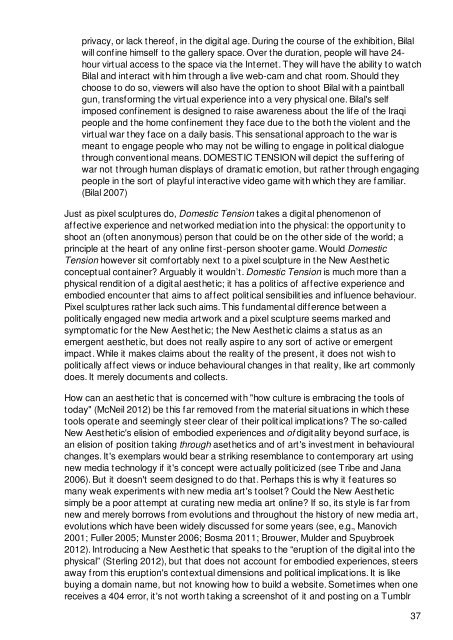New Aesthetic New Anxieties - Institute for the Unstable Media
New Aesthetic New Anxieties - Institute for the Unstable Media
New Aesthetic New Anxieties - Institute for the Unstable Media
Create successful ePaper yourself
Turn your PDF publications into a flip-book with our unique Google optimized e-Paper software.
privacy, or lack <strong>the</strong>reof, in <strong>the</strong> digital age. During <strong>the</strong> course of <strong>the</strong> exhibition, Bilalwill confine himself to <strong>the</strong> gallery space. Over <strong>the</strong> duration, people will have 24-hour virtual access to <strong>the</strong> space via <strong>the</strong> Internet. They will have <strong>the</strong> ability to watchBilal and interact with him through a live web-cam and chat room. Should <strong>the</strong>ychoose to do so, viewers will also have <strong>the</strong> option to shoot Bilal with a paintballgun, trans<strong>for</strong>ming <strong>the</strong> virtual experience into a very physical one. Bilal's selfimposed confinement is designed to raise awareness about <strong>the</strong> life of <strong>the</strong> Iraqipeople and <strong>the</strong> home confinement <strong>the</strong>y face due to <strong>the</strong> both <strong>the</strong> violent and <strong>the</strong>virtual war <strong>the</strong>y face on a daily basis. This sensational approach to <strong>the</strong> war ismeant to engage people who may not be willing to engage in political dialoguethrough conventional means. DOMESTIC TENSION will depict <strong>the</strong> suffering ofwar not through human displays of dramatic emotion, but ra<strong>the</strong>r through engagingpeople in <strong>the</strong> sort of playful interactive video game with which <strong>the</strong>y are familiar.(Bilal 2007)Just as pixel sculptures do, Domestic Tension takes a digital phenomenon ofaffective experience and networked mediation into <strong>the</strong> physical: <strong>the</strong> opportunity toshoot an (often anonymous) person that could be on <strong>the</strong> o<strong>the</strong>r side of <strong>the</strong> world; aprinciple at <strong>the</strong> heart of any online first-person shooter game. Would DomesticTension however sit com<strong>for</strong>tably next to a pixel sculpture in <strong>the</strong> <strong>New</strong> <strong>Aes<strong>the</strong>tic</strong>conceptual container? Arguably it wouldn’t. Domestic Tension is much more than aphysical rendition of a digital aes<strong>the</strong>tic; it has a politics of affective experience andembodied encounter that aims to affect political sensibilities and influence behaviour.Pixel sculptures ra<strong>the</strong>r lack such aims. This fundamental difference between apolitically engaged new media artwork and a pixel sculpture seems marked andsymptomatic <strong>for</strong> <strong>the</strong> <strong>New</strong> <strong>Aes<strong>the</strong>tic</strong>; <strong>the</strong> <strong>New</strong> <strong>Aes<strong>the</strong>tic</strong> claims a status as anemergent aes<strong>the</strong>tic, but does not really aspire to any sort of active or emergentimpact. While it makes claims about <strong>the</strong> reality of <strong>the</strong> present, it does not wish topolitically affect views or induce behavioural changes in that reality, like art commonlydoes. It merely documents and collects.How can an aes<strong>the</strong>tic that is concerned with "how culture is embracing <strong>the</strong> tools oftoday" (McNeil 2012) be this far removed from <strong>the</strong> material situations in which <strong>the</strong>setools operate and seemingly steer clear of <strong>the</strong>ir political implications? The so-called<strong>New</strong> <strong>Aes<strong>the</strong>tic</strong>'s elision of embodied experiences and of digitality beyond surface, isan elision of position taking through ase<strong>the</strong>tics and of art's investment in behaviouralchanges. It's exemplars would bear a striking resemblance to contemporary art usingnew media technology if it's concept were actually politicized (see Tribe and Jana2006). But it doesn't seem designed to do that. Perhaps this is why it features somany weak experiments with new media art's toolset? Could <strong>the</strong> <strong>New</strong> <strong>Aes<strong>the</strong>tic</strong>simply be a poor attempt at curating new media art online? If so, its style is far fromnew and merely borrows from evolutions and throughout <strong>the</strong> history of new media art,evolutions which have been widely discussed <strong>for</strong> some years (see, e.g., Manovich2001; Fuller 2005; Munster 2006; Bosma 2011; Brouwer, Mulder and Spuybroek2012). Introducing a <strong>New</strong> <strong>Aes<strong>the</strong>tic</strong> that speaks to <strong>the</strong> “eruption of <strong>the</strong> digital into <strong>the</strong>physical” (Sterling 2012), but that does not account <strong>for</strong> embodied experiences, steersaway from this eruption's contextual dimensions and political implications. It is likebuying a domain name, but not knowing how to build a website. Sometimes when onereceives a 404 error, it's not worth taking a screenshot of it and posting on a Tumblr37








